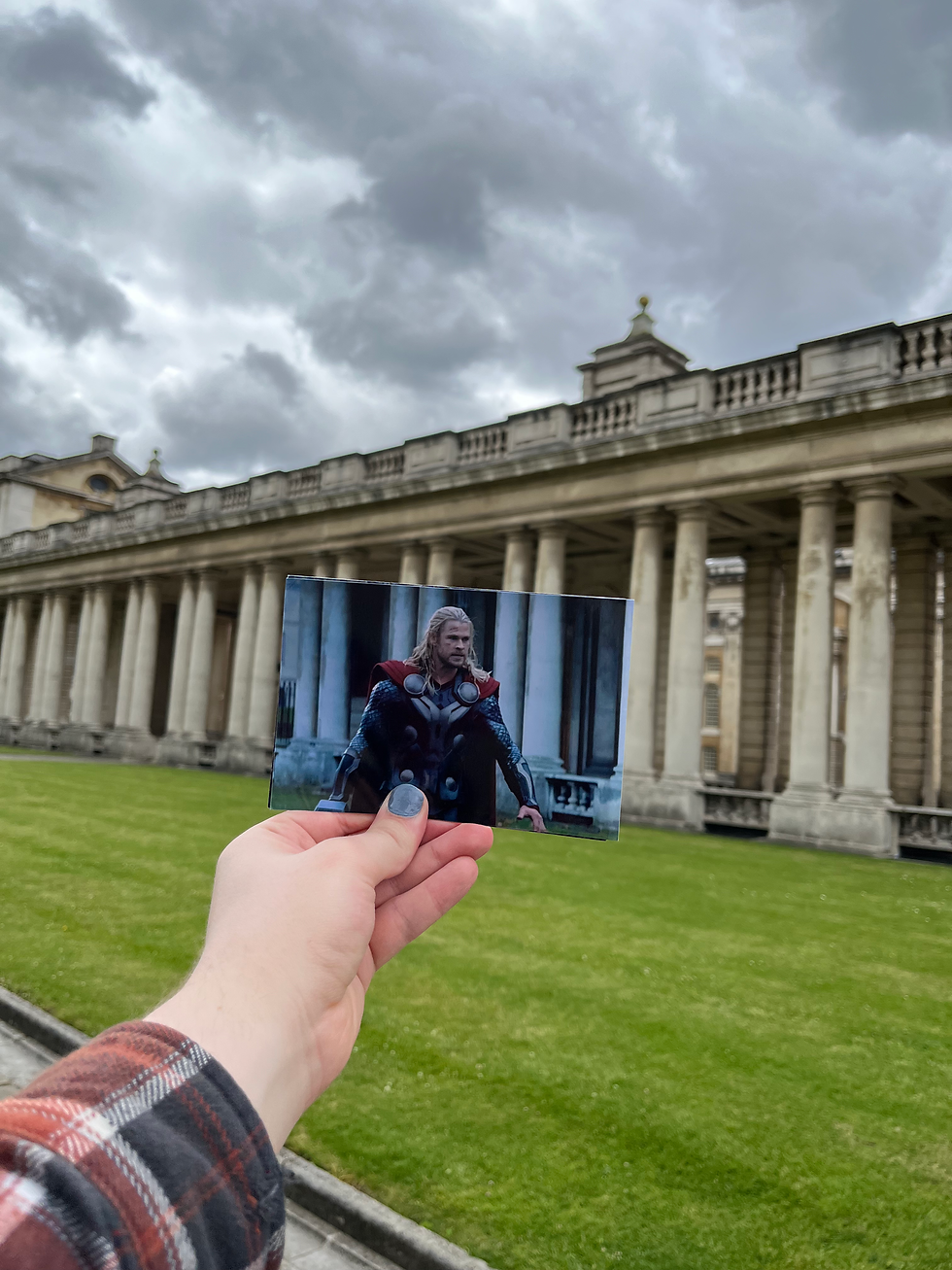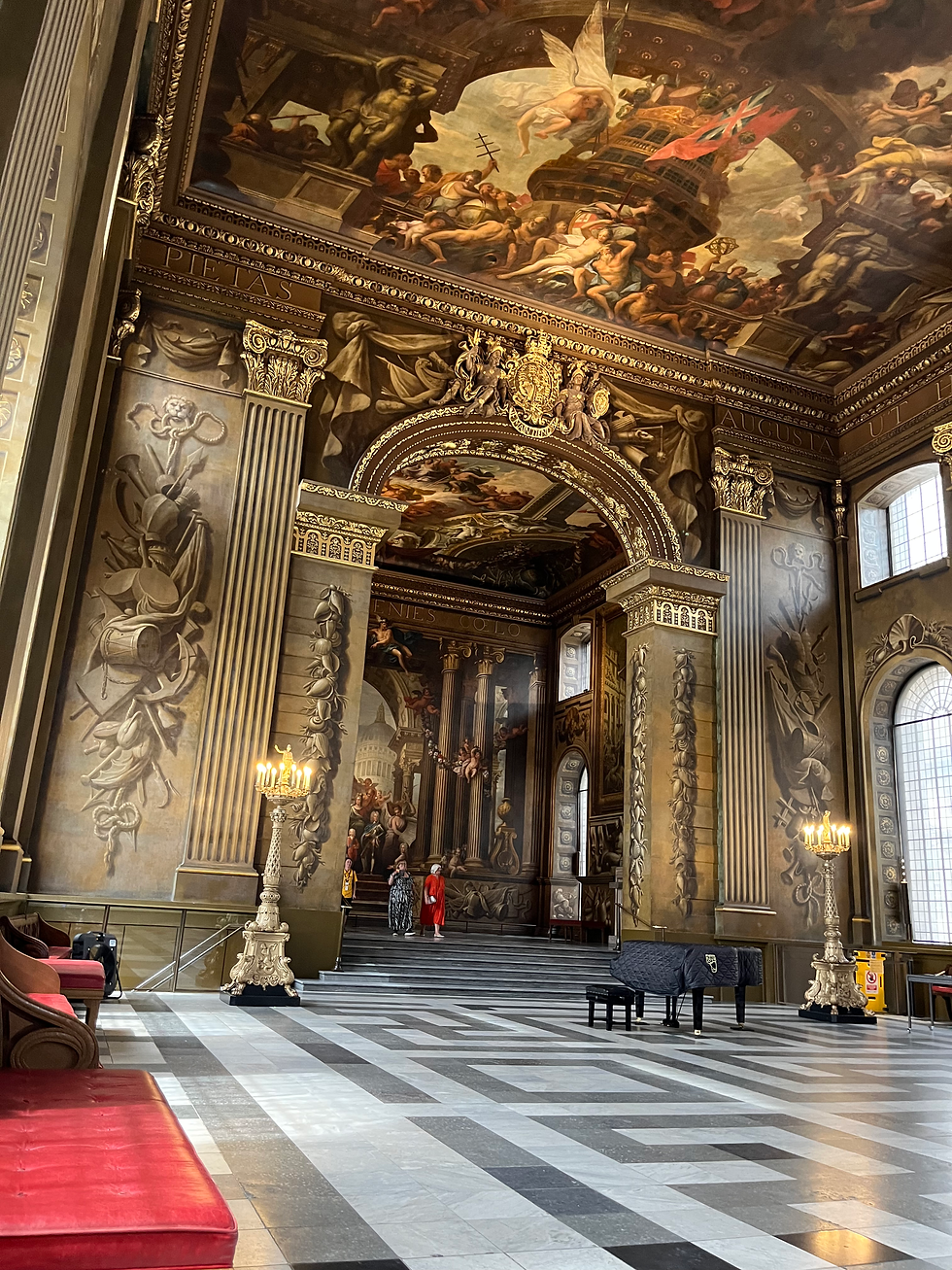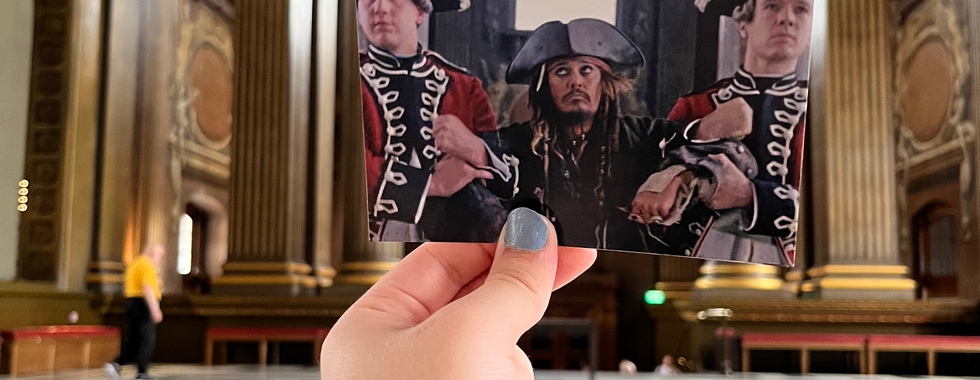Set Jetting in Style! Step into the spotlight at the Greenwich Naval College
- joshanthonyharris
- Oct 17
- 9 min read
The Old Royal Naval College, stands proudly on the banks of the River Thames as one of London's most iconic historical landmarks. Originally designed in the late 17th century by Sir Christopher Wren, it began life as the Royal Hospital for Seamen. In the 19th century, it transitioned into a training establishment for naval officers, eventually becoming the Royal Naval College that was in operation until 1998. Today the buildings form part of Maritime Greenwich, a UNESCO World Heritage Site which is celebrated for the grandeur and rich maritime legacy.
This stunning location has also become a magnet for filmmakers, thanks to its dramatic courtyards, sweeping colonnades and pristine period architecture. Its versatile backdrop has allowed it to double for a wide range of historical settings, spanning centuries and continents. The Naval College has appeared in countless film and TV productions, from regal palaces and wartime streets to fictional kingdoms, it has become a cornerstone of British film tourism.
King William Court & Queen Mary Court

At the heart of the Old Royal Naval College complex lie two of its most recognisable sections: King William Court and Queen Mary Court. These symmetrical quadrangles, flanked by domed towers and sweeping colonnades, have a stately Baroque appearance that form a striking axis that aligns with the river and Queens Park. This planned grandeur was intended to reflect both the power of the monarchy and the dignity afforded to naval pensioners.
King William Court houses two of the complex’s major interior attractions: the Painted Hall and the King William Undercroft. Queen Mary Court mirrors it across the Grand Square, contributing to the site's symmetry. Together, the two courts present a cohesive aesthetic of stone facades, arcaded walkways, and distinctive domes crowned with gilded weather vanes. The surrounding colonnades create a sense of enclosure while also offering dramatic sight-lines across the Thames and towards the London skyline. This blend of elegance and versatility has made King William Court and Queen Mary Court ideal filming locations. Filmmakers are drawn to the ability to double as almost any royal palace, bustling city squares or grand European setting, without the need for extensive alterations. The architecture is period-authentic but adaptable to different eras, whether the 18th century, the French Revolution, or even fantastical universes.

One of the most notable uses of these courts was in Les Miserables, where the colonnades and courtyard areas were transformed into the streets of revolutionary Paris. With the addition of set dressing and costumed crowds, the space convincingly became a bustling 19th-century urban centre. Similarly, Pirates of the Caribbean: On Stranger Tides, used the area to portray London during the reign of King George II, with Jack Sparrow running through the courtyard onto the carriage.
The Crown, the Netflix series known for its dedication to authenticity, used the grand period buildings to stand in for not only Buckingham Palace but various other royal settings. Their surroundings served equally well in The Kings Speech and Sense and Sensibility, where the timeless environment enhanced the authenticity of each production. Even modern and fantasy films have used these buildings as backdrops. Thor: The Dark World, used the courtyards to create scenes set in both London and Asgard, cleverly blending CGI with the existing architecture. The juxtaposition of period stonework with high-tech visual effects demonstrates the flexibility of the space.
Production teams value the scale and accessibility of the courts. The open courtyards provide space for complex camera setups, choreography, and large casts. Meanwhile, the colonnades allow for weather protection and creative camera angles. Because the courts remain relatively unchanged since their construction, post-production teams can rely on minimal digital alteration.
The Grand Square

The Grand Square, also known as the Grand Axis, is the central open space that highlights the architectural symmetry of the Old Royal Naval College. Flanked by King William Court and Queen Mary Court, the square’s sweeping vistas, stone pathways and distant city skylines framed by domes and colonnades make it one of the most photogenic areas of the complex.
Its scale and unobstructed layout provide a flexible canvas for filmmakers. The Grand Square has frequently been transformed to double for palatial courtyards, royal parades, bustling European cities, and historical settings from various centuries. Productions often use the square for wide establishing shots, processions and crowd scenes, taking advantage of its symmetry and openness. Because the square connects seamlessly with the riverfront and the courtyards beyond, it offers filmmakers continuity and scale rarely available in historic urban locations. Its adaptability and elegance ensure it remains a favourite backdrop across film and television.
From standing in as Berlin during Muppets Most Wanted, to Buckingham Palace in The Crown and The Queen, to London Streets in The Kings Speech and Bones. This site offers the production team a blank slate to create various worlds around the grand architecture.
The Colonnades

The colonnades of the Old Royal Naval College are among its most distinctive and cinematic features. As mentioned before, these long, covered walkways run along the sides of King William Court and Queen Mary Court, connecting the main buildings and framing the Grand Square. Their rows of classical columns, vaulted ceilings and stone floors create a unique sense of grandeur that works perfectly on camera. Designed in the Baroque style, the colonnades provide both architectural elegance and atmospheric depth, offering shelter, shadow and perspective that instantly evoke history.

For filmmakers, the provide a versatile asset, with a neutral yet characterful design, that allows them to represent a variety of locations. Directors often use them for dramatic entrances, chase sequences, and dialogue scenes, thanks to their symmetry, natural light control, and ability to frame characters in motion.
These have been used plenty of times within various film and TV productions. In The Dark Knight, the space was used for a cafe in Florence where Alfred spots Bruce Wayne sitting at another table. They were dressed up with various florals and several market stalls to create a bustling Regency market for Bridgerton Series 3. Another use of the colonnades was for Ridley Scott Napoleon movie where they were used as 1799 France.
Chapel of Saint Peter & Saint Paul

The Chapel of St Peter and St Paul, is one of the most exquisite examples of 18th-century ecclesiastical architecture in Britain. Completed in 1751 and redesigned after a fire in 1779, the chapel we see today is largely the work of James Stuart and William Newton. Blending neoclassical elegance with maritime symbolism, befitting its original purpose as a place of worship for naval pensioners.
Stepping inside, visitors are greeted by an interior that balances grandeur with serenity. The decorative plaster ceiling features delicate patterns in soft tones, while the altar is adorned with a striking altarpiece depicting St Paul’s shipwreck, painted by Benjamin West. Slim columns with Corinthian capitals line the nave, and the spacious layout allows light to filter through tall windows, illuminating the pale walls and intricate floor tiles. The chapel’s wooden galleries and pipe organ further contribute to its atmosphere of quiet dignity.

This combination of historical authenticity, visual harmony and fine craftsmanship has made the chapel a sought-after filming location. Its neoclassical style is versatile enough to represent various eras, from the Georgian and Regency periods to early Victorian settings. Production designers appreciate the chapel’s preserved state, which requires minimal alteration for filming—often just the addition of props or lighting to suit a particular narrative. The setting's calm beauty and symmetrical design lend themselves to scenes of reflection, ceremony or quiet tension.
Filming logistics are also favourable. The chapel is accessible yet contained, making it easier to control sound, lighting and equipment placement. Its proximity to other parts of the complex means it can be paired seamlessly with exterior shots in the colonnades, courtyards or riverfront, helping maintain visual continuity across a production.

This Chapel can be spotted many times throughout various film and TV productions. Whilst mostly used as a chapel, the location of the chapel often changes. From The Crown and Four Weddings and a Funeral, where it was located in London, to The Kingsman: Secret Service and Doctor Strange where it was given a more American feel to it. More recently the chapel has been given two different time periods, being used in Bridgerton Series 3 for Colin & Penelope's wedding, to The Conjuring Last Rites when it was used as a late 20th century Philadelphia chapel.
The Painted Hall

The Painted Hall at the Old Royal Naval College is one of Britain’s most breathtaking Baroque interiors and a favourite among filmmakers. Designed by Sir Christopher Wren and Nicholas Hawksmoor and painted by Sir James Thornhill between 1707 and 1726, it was originally created as a grand dining hall for naval pensioners. Its sheer splendour, however, soon made it better suited for ceremony than everyday use. With artwork spanning around 40,000 square feet across the ceiling and walls, depicting over 200 allegorical figures celebrating the British Crown, maritime power, and the Protestant succession. The hall is divided into the Vestibule, Lower Hall and Upper Hall, with Corinthian columns, oak panelling, and dramatic natural light adding to its impact. A major restoration completed in 2019 revived the vibrancy of the original paintings, bringing the space back to life for both visitors and production crews.

Its opulence and scale make it a go-to location for period dramas, royal settings and historical adaptations. In Napoleon, it convincingly stood in as a French royal interior, requiring minimal set dressing thanks to its ornate backdrop. Pirates of the Caribbean: On Stranger Tides transformed it into a regal British chamber, while Victoria & Abdul and The Crown used it to evoke the grandeur of monarchy. Thor: The Dark World blended CGI with the hall’s dramatic setting to create otherworldly scenes.
Filmmakers value the Painted Hall not just for its beauty but for its versatility. While the allegorical art avoids being too specific to one country or period, the space can shift effortlessly between 18th-century France, Georgian Britain or fictional realms. Blending art, architecture and cinema, the Painted Hall remains one of the UK’s most cinematic historic interiors—an unforgettable setting both on screen and in person.
Other Notable Filming
Beyond its most famous screen appearances, the Old Royal Naval College has featured in a wide variety of film and television productions thanks to its adaptable architecture and atmospheric grounds.
One notable example is the James Bond franchise. In Skyfall, lawns and surrounding areas were used to stage scenes creating a convincing backdrop for part of the film’s high-stakes narrative. The location’s proximity to the Thames and its imposing classical façades gave the sequence an air of authority and cinematic scale.
The college also made an appearance in Sherlock Holmes, starring Robert Downey Jr. The exterior grounds and colonnades provided the ideal setting for Victorian London, with minimal set dressing needed to conjure the era’s atmospheric streets and civic structures. They enjoyed filming here so much that they returned for the second film in the series setting up a bustling market in one of the courtyards.
Television adaptations such as Call the Midwife and Poldark have also utilised parts of the complex to convey different periods of British history. Even contemporary productions, music videos and commercials have taken advantage of its grand exteriors and controlled filming environment. All this proves that the Old Royal Naval College continues to provide one of the UK’s most versatile filming locations.
My Travel Tips
If you’re planning a film-inspired visit to the Old Royal Naval College in Greenwich, here are a few tips to make the most of your trip:
Plan Ahead: Entry to the grounds is free, but tickets are required for highlights like the Painted Hall and guided tours. Check the official website for opening hours and special events, as filming or private functions may limit access to certain areas.
Take a Film Tour: The college offers dedicated film and TV tours where guides point out famous filming spots from Les Miserables, The Crown, Pirates of the Caribbean and more. These tours are perfect for spotting exact locations from your favourite productions.
Best Photography Spots: The colonnades and Grand Square provide fantastic angles of the domes, while the Painted Hall is a must for interior shots. The riverside steps also offer sweeping views across to Canary Wharf.
Combine with Nearby Attractions: The complex sits at the heart of Maritime Greenwich, a UNESCO World Heritage Site. The Queen’s House, Greenwich Park and the Royal Observatory are all within walking distance and have their own cinematic history, making it easy to plan a full day of exploring.
Travel Connections: Greenwich is accessible via Docklands Light Railway (DLR), riverboat from central London, or a short train ride from London Bridge.
The Old Royal Naval College in Greenwich is more than just a historic landmark, it’s a living cinematic playground. From the grandeur of the Painted Hall and the serene elegance of the chapel to the sweeping colonnades, courts, and Grand Square, each corner of the complex has played a starring role on screen. Whether you’re a history enthusiast, architecture lover, or devoted film tourist, exploring this iconic site offers a unique chance to walk through centuries of British heritage while stepping into the worlds of your favourite films and TV shows. With its rich history and versatile spaces, the Naval College continues to inspire storytellers and captivate visitors alike.

























































Comments